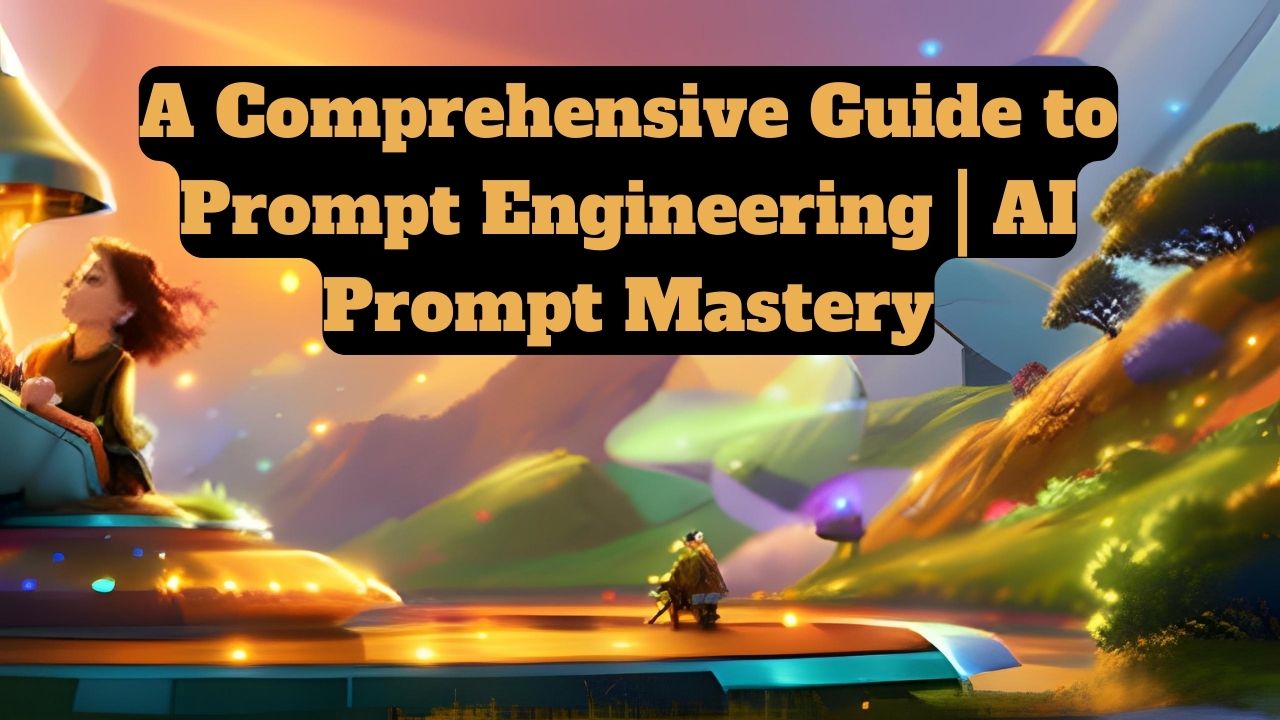Introduction
Prompt engineering has developed as a critical feature of several sectors in the fast-paced digital environment. Prompt engineering is critical in changing the way machines engage with humans, from natural language processing to conversational AI. This thorough handbook is your one-stop shop for learning about the complexities of timely engineering. Whether you are an experienced developer or a curious enthusiast, this article will provide you with the information and expertise required to flourish in rapid engineering.
Understanding the Basics
To properly understand the core of rapid engineering, we must go back to its roots, investigating the fundamental concepts that form the foundations of this fascinating area. We obtain a better understanding of its relevance and potential in molding the future of technology and human-computer interactions by looking into its origins.
Prompt engineering is the art of creating prompts or instructions that are given to artificial intelligence (AI) models to enable them to produce desired outcomes. These cues serve as catalysts, directing AI systems' vast capabilities toward specific tasks and applications ranging from language production and translation to image synthesis and problem solving.
To comprehend the beginnings of quick engineering, we must first acknowledge the critical role that natural language processing (NLP) and machine learning played. NLP is the branch of artificial intelligence that focuses on teaching robots to understand, interpret, and generate human language. Machine learning, on the other hand, is the creation of algorithms that enable AI models to learn patterns and anticipate outcomes based on massive volumes of data.
The concept of prompts arose from the merging of these two domains. Early AI systems relied on inflexible, preset input formats, which limited their adaptability and reach. However, as NLP and machine learning technologies advanced, researchers discovered that flexible and dynamic prompts might be used to unlock the true potential of AI models. This discovery ushered in prompt engineering as we know it today.
Prompt engineering necessitates a precise mix between specificity and generality. Prompts provide specific instructions and context to steer the AI model to the intended result. General prompts, on the other hand, enable the model to use its innate talents to develop different and creative responses.
The development of "prompt engineering tricks," which are approaches used to alter AI model behavior through tiny changes in prompts, was one of the milestones in prompt engineering. These techniques can be used to fine-tune the model's output, making it more trustworthy, controllable, or even surprising.
As rapid engineering evolved, researchers and developers saw its promise in a variety of sectors. Prompt engineering, for example, is critical in natural language processing for creating coherent and contextually relevant responses, eliminating bias, and adapting AI-generated material for specific audiences.
Furthermore, prompt engineering is critical in domains such as question-answering systems, where well-crafted prompts allow AI models to offer accurate and relevant answers to user questions. Prompts become a significant tool in creative applications to stimulate AI-generated art, music, and tales.
However, there are several obstacles in the subject of prompt engineering, such as the possibility of accidental biases in prompts or the difficulty of designing prompts for complex and multi-faceted activities. Maintaining the trust and reliability of AI systems requires ensuring ethical practices and openness in prompt engineering.
Prompt Engineering Defined:
Prompt engineering is a crucial procedure in the field of artificial intelligence (AI) that entails developing precisely tailored and context-aware instructions for AI systems. These instructions, known as prompts, are critical in directing the AI model to provide correct and relevant results.
Simply expressed, prompt engineering is the process of supplying the AI system with the necessary instructions to do a certain task. A correctly written prompt can prompt the AI to provide the desired response, just as a well-crafted question can elicit a precise answer from a human.
The procedure comprises carefully considering the prompt's wording, structure, and context to ensure that it properly communicates the task at hand. Making the prompts context-aware allows the AI model to better understand the nuances and intricacies of the input, resulting in more accurate and insightful outputs.
Striking a balance between specificity and generality is an important part of prompt engineering. Specific prompts provide the AI system with clear and direct instructions, ensuring that it concentrates on specific areas of the task. More generic instructions, on the other hand, allow the AI to use its greater understanding and imagination to deliver various and inventive results.
Prompt engineering is important in many AI applications, including natural language processing, image identification, and decision-making systems. In language translation, for example, a well-crafted prompt can lead to more exact and contextually relevant translations, minimizing misinterpretations and errors.
The Role of LSI Keywords:
Keywords from Latent Semantic Indexing (LSI) are essential for prompt engineering. They make certain that the prompts are varied and cover a wide spectrum of probable user queries. LSI keywords improve AI model performance and flexibility.
Components of a Perfect Prompt
Developing effective prompts necessitates a solid understanding of their key components. Let's look at the main parts that make up a great prompt.
Context Awareness:
The greatest prompts are context-aware, taking previous interactions and user intent into account. Contextual suggestions result in more coherent and precise AI responses.
Clarity and Simplicity:
Prompts that are clear and brief are essential for eliciting exact responses from AI systems. Better results are obtained by avoiding ambiguity and complex wording.
Personalization:
Individualizing prompts increases user engagement and happiness. Personalization results in a more human-like dialogue with AI.
Techniques for Advanced Prompt Engineering
As you become more familiar with the fundamentals, it's time to investigate sophisticated strategies that will improve your prompt engineering abilities.
Transfer Learning:
A powerful prompt engineering strategy is to use pre-trained language models and fine-tune them for specific applications. Transfer learning speeds up model development while improving performance.
Data Augmentation:
Using data augmentation approaches, you can increase the variety and quality of prompts. This entails creating variations of current prompts in order to expand the training dataset.
Reinforcement Learning:
Optimize quick engineering using reinforcement learning, a technique in which AI models learn from their own outputs and are rewarded for desired behavior.
Use Cases and Applications
The applications of rapid engineering are numerous and growing. Let's look at some important use cases from various domains.
Natural Language Processing (NLP):
NLP tasks such as sentiment analysis, machine translation, and question-answering systems rely on prompt engineering.
Chatbots and Virtual Assistants:
To engage consumers in human-like discussions and deliver valuable advice, chatbots rely on well-crafted prompts.
Content Generation:
Prompt engineering is used in AI-driven content generation to generate articles, product descriptions, and creative writing.
Challenges and Pitfalls to Avoid
Even the most experienced quick engineers have difficulties along the way. Let's look at some frequent mistakes and how to avoid them.
Bias and Fairness:
Biased prompts can result in biased AI replies, sustaining inequitable outcomes. Audit prompts on a regular basis to guarantee fairness and inclusion.
Context Shift:
Context can vary quickly in dynamic talks. It is critical to maintain consistency by adapting cues to different settings.
Data Quality:
Poor-quality suggestions or data might have a negative impact on AI performance. It is critical to ensure high-quality data inputs.
The Future of Prompt Engineering
The future of prompt engineering promises intriguing possibilities as technology improves. Let's take a look at what's to come.
Interactive Prompting:
Interactive prompts that engage users in two-way interactions are anticipated to become increasingly common, improving user experiences.
Multi-Modal Prompting:
Text, pictures, and other modalities combined in prompts will result in more powerful and diverse AI interactions.
Ethical Prompt Engineering:
Prompt engineering techniques will be shaped by ethical considerations, with a focus on responsible AI development.
Frequently Asked Questions (FAQs)
How important is prompt engineering for AI development?
Prompt engineering is a critical component in AI development. Prompts that are well-crafted have a substantial impact on AI model performance and user experience.
What are some of the most prevalent issues that prompt engineers face?
Prompt engineers frequently face bias, context shift, and data quality issues. Addressing these issues ensures improved AI outcomes.
Can prompt engineering have an impact on AI ethics?
Yes, timely engineering is critical to ensure AI ethics. Ethical prompt engineering aids in the development of fair and responsible AI applications.
How can I improve my quick engineering skills?
To improve prompt engineering skills, stay current on research, practice various methodologies, and participate in prompt engineering communities.
Which industries stand to gain the most from quick engineering?
Prompt engineering-driven AI solutions greatly help industries such as healthcare, customer service, finance, and content creation.
How can I assess the efficacy of my prompts?
Measuring prompt efficacy entails assessing the quality of AI output, user input, and adherence to set objectives.
Conclusion
Congratulations! You've finished reading this comprehensive guide to prompt engineering. From the fundamentals to advanced techniques, you now have the knowledge and expertise to create successful prompts for AI systems. Accept the opportunities and challenges that prompt engineering presents, and set out on your path to alter the world of artificial intelligence.
Remember that prompt engineering is a dynamic field that requires ongoing study and exploration. So keep honing your abilities, contributing to the fast-paced engineering community, and staying up to date on the latest advances. Happy quick engineering!
#PromptEngineering #AIprompts #ArtificialIntelligence #NLP #MachineLearning #ContextAwareness #BiasMitigation #AIInteractions #EthicalAI #AIApplications
#SmartTech #FutureTech #TechInnovation #AIProgress #HumanComputerInteraction
#AIModeling #InnovationInAI #AIForGood #AIResearch #IntelligentSystems
Written by: Md Muktar Hossain
























